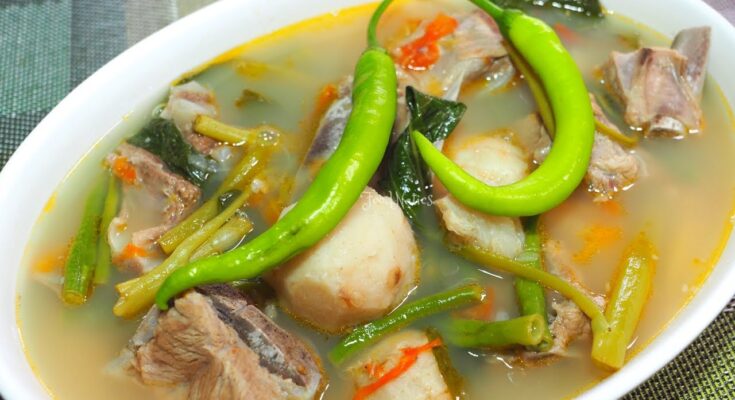Pork Sinigang Recipe: There’s nothing quite like a steaming bowl of Pork Sinigang to warm your soul and satisfy your cravings. This beloved Filipino dish is more than just a meal—it’s a taste of home. Its rich, savory broth and tangy flavor make it one of the Philippines’ most iconic comfort foods. Whether it’s raining outside or you simply miss home-cooked meals, a hearty bowl of Sinigang will always hit the spot.
What is Sinigang?
Sinigang is a traditional Filipino sour soup made with meat, vegetables, and a tangy broth typically flavored with tamarind. The word “sinigang” comes from the Tagalog term meaning “to stew” or “to simmer.” While pork is the most popular version, there are also variations using beef, shrimp, or fish. The sourness of Sinigang is what sets it apart from other Filipino soups—it’s both refreshing and hearty, perfect for any time of the year.
The Filipino Love for Sour Soups
Filipinos have a deep affection for sour dishes, and Sinigang perfectly embodies that love. It’s not just food—it’s an emotion tied to family gatherings, rainy afternoons, and Sunday lunches. The tangy broth awakens the appetite and pairs beautifully with rice, making every spoonful a delightful experience. Whether you’re from Luzon, Visayas, or Mindanao, Sinigang has a special place in every Filipino’s heart.
Why Pork Sinigang Stands Out
Among all Sinigang versions, Pork Sinigang remains the most popular. The richness of pork complements the tanginess of the tamarind, creating a well-balanced flavor. The fat from the pork belly or ribs gives the soup depth and creaminess, while the vegetables add freshness and crunch. It’s comfort in a bowl—simple, satisfying, and irresistibly delicious.
Ingredients You’ll Need
To make the perfect Pork Sinigang, you’ll need a mix of fresh vegetables, tender pork, and flavorful seasonings. Here’s what you’ll need:
Main Ingredients
- 1 kg (2.2 lbs) pork belly or ribs (liempo or baboy na may buto)
- 8 cups water
- 1 medium onion, quartered
- 2 medium tomatoes, quartered
- 2 tablespoons fish sauce (patis)
- Salt and pepper to taste
Vegetables for Sinigang
- 1 bunch kangkong (water spinach), leaves and tender stalks
- 1 medium radish (labanos), sliced diagonally
- 5 pieces okra
- 2 pieces eggplant (talong), sliced
- 1 bunch string beans (sitaw), cut into 2-inch pieces
- 2 long green chilies (siling pansigang)
Flavoring and Seasoning Essentials
- 1 packet tamarind soup base (Sinigang sa Sampalok Mix) or
1 cup fresh tamarind pulp - Fish sauce (patis) for seasoning
- Optional: MSG or seasoning granules for enhanced flavor
Optional Add-Ons and Substitutes
You can personalize your Sinigang by adding:
- Taro (gabi) for a thicker, creamier broth
- Kangkong stems for extra crunch
- Fresh sampalok pods for a natural sour flavor
- Green beans or spinach as vegetable substitutes
If you can’t find tamarind mix, try using calamansi, green mango, or kamias as alternative souring agents.
Preparing the Ingredients
Before cooking, proper preparation ensures your Sinigang tastes authentic and delicious.
Choosing the Right Cut of Pork
The secret to a flavorful Sinigang lies in your choice of pork. The best cuts are pork belly (liempo) and pork ribs (baboy na may buto) because they have the right balance of fat and meat. The fat adds richness and depth to the broth, while the bones release natural flavor during simmering. Avoid lean cuts—they can make your soup taste flat.
Cleaning and Cutting the Vegetables
Wash all vegetables thoroughly to remove dirt and pesticides. Cut them into uniform pieces so they cook evenly. The radish and eggplant should be sliced diagonally for better presentation. The string beans and kangkong should be cut just before cooking to preserve freshness.
Prepping the Tamarind Base (or Sinigang Mix)
If you’re using fresh tamarind, boil the pods until soft, then mash and strain the juice. This gives your soup a more natural, earthy tang. However, if you’re short on time, Sinigang sa Sampalok Mix works perfectly—it delivers the same authentic sourness with less hassle.
Step-by-Step Guide to Cooking Pork Sinigang
Step 1: Boiling the Pork
In a large pot, pour 8 cups of water and add the pork, onion, and tomatoes. Bring to a boil over medium heat, skimming off the scum that rises to the top. This keeps the broth clear. Once boiling, lower the heat and simmer for 45 minutes to 1 hour or until the pork is tender. The longer it simmers, the richer the flavor.
Step 2: Adding the Vegetables
Once the pork is tender, add the radish, okra, eggplant, and string beans. Let them cook for about 5–8 minutes or until tender-crisp. The vegetables should not be overcooked; they must retain their color and slight crunch.
Step 3: Seasoning the Soup
Add fish sauce and salt to taste. Stir well. The fish sauce adds umami and depth to the flavor profile. Adjust the seasoning gradually—you can always add more later.
Step 4: Adding the Tamarind Flavor
Now comes the heart of the dish—the sour base. Pour in the tamarind soup mix (or fresh tamarind juice) and stir. Let it simmer for another 5 minutes, allowing the sourness to infuse into the broth. Taste and adjust: add more mix for extra tang or water for a milder flavor.
Step 5: Final Taste Test and Serving
Finally, add the kangkong leaves and green chilies. Let them wilt for a minute before turning off the heat. Serve your Pork Sinigang hot with a side of steamed white rice—it’s the ultimate Filipino comfort food.
Tips for the Best Pork Sinigang
Cooking Pork Sinigang might seem simple, but mastering its balance of flavors takes a bit of practice. The sourness, saltiness, and umami need to work in harmony to create that perfect comforting taste. Here are some tried-and-tested tips to help you make the best Pork Sinigang every time.
Balancing the Sourness
The soul of Sinigang lies in its sourness, but too much tamarind can make the dish overpowering. Start by adding a small amount of tamarind mix or juice, taste the broth, and then gradually increase until it reaches your desired tanginess. Remember, you can always add more souring agent, but you can’t take it away once it’s too sour. For a well-rounded flavor, balance the tang with a bit of salt or fish sauce, which enhances the pork’s savory taste.
Choosing Fresh Ingredients
The fresher your ingredients, the better your Sinigang will taste. Always choose fresh, bright vegetables—the kind that snap when bent. When selecting pork, look for cuts with marbling (fat streaks) for added flavor. Avoid frozen or pre-packaged meats if possible; freshly butchered pork releases more natural juices, making your broth richer. Using ripe tomatoes and onions also helps in deepening the soup’s base flavor.
Enhancing the Flavor Profile
Want to elevate your Sinigang to the next level? Add gabi (taro root) while simmering the pork. It gives the broth a slightly creamy texture and thickens it naturally. You can also toss in a few lemongrass stalks or ginger slices for an aromatic twist. For those who love heat, include a couple of red chilies for a mildly spicy kick that complements the sour notes beautifully.
Variations of Sinigang
One of the best things about Sinigang is its versatility. You can swap out the protein or modify the souring agent to create delicious variations. Here are a few of the most popular ones across the Philippines.
Sinigang na Hipon (Shrimp Sinigang)
If you love seafood, this version is a must-try. Sinigang na Hipon replaces pork with fresh shrimp, resulting in a lighter but equally flavorful broth. The natural sweetness of the shrimp perfectly balances the tamarind’s acidity. It’s also quicker to prepare since shrimp cooks faster than pork. Just be careful not to overcook the shrimp—it only needs a few minutes until it turns pink and tender.
Sinigang na Bangus (Milkfish Sinigang)
This fish-based variation is especially popular in coastal regions. Bangus (milkfish) brings a subtle, delicate flavor that works beautifully with the sour broth. Some people even add mustard leaves (mustasa) to cut through the fish’s natural richness. For a smokier flavor, try Sinigang na Bangus sa Miso, where miso paste adds depth and a slightly creamy consistency.
Beef Sinigang
For meat lovers, Beef Sinigang offers a heartier alternative. The best cut for this is beef shank (bulalo) or short ribs, which create a rich, full-bodied broth. This version takes longer to cook because the beef needs time to become tender, but the result is worth the wait. The tangy-sour soup paired with melt-in-your-mouth beef is simply divine.
Serving Suggestions
The way you serve your Sinigang can make a big difference in the dining experience. Presentation, side dishes, and pairings all add to its charm. Let’s explore the best ways to serve this beloved Filipino dish.
Perfect Side Dishes
Sinigang pairs well with a variety of Filipino side dishes. A classic choice is fried or grilled fish, which adds a crispy, savory contrast to the soup. Another favorite is pork tocino or longganisa for those who prefer a sweeter side. For a truly traditional meal, serve Sinigang with bagoong (fermented shrimp paste) on the side—it enhances the flavors and adds that extra umami punch.
Ideal Rice Pairings
No Sinigang meal is complete without steamed white rice. The rice absorbs the tangy broth perfectly, balancing the sourness and saltiness in every bite. Some people prefer garlic fried rice (sinangag) for an extra layer of flavor, especially during breakfast or lunch. You can also try brown rice or red rice if you want a healthier, fiber-rich option.
Best Drinks to Enjoy with Sinigang
To complement the savory and sour flavors of Sinigang, opt for refreshing beverages like calamansi juice, iced tea, or buko (coconut) juice. If you prefer something traditional, sago’t gulaman—a sweet Filipino drink with tapioca pearls—provides the perfect contrast. On colder days, a hot ginger tea (salabat) makes a soothing companion to your warm bowl of Sinigang.
Health Benefits of Pork Sinigang
While Sinigang is undeniably delicious, it’s also surprisingly healthy when prepared mindfully. It’s packed with nutrients from vegetables and proteins, making it a wholesome dish fit for the whole family.
Nutritional Value
A serving of Pork Sinigang is rich in protein from pork, vitamins and minerals from vegetables, and antioxidants from tamarind and tomatoes. The soup base itself is hydrating and low in fat (if you skim off excess oil). Tamarind contains vitamin C, which boosts the immune system, while vegetables like kangkong and radish offer fiber and antioxidants for better digestion and detoxification.
Benefits of Tamarind and Vegetables
Tamarind is known for aiding digestion and improving heart health. Its tangy flavor comes from tartaric acid, a natural antioxidant that helps neutralize harmful free radicals in the body. The vegetables in Sinigang—okra, eggplant, kangkong, and sitaw—are all low in calories but high in nutrients. Together, they make Sinigang not only comforting but also beneficial for your overall health.
Common Mistakes to Avoid
Even experienced cooks can make mistakes when preparing Sinigang. To help you avoid common pitfalls, here are some tips to ensure your dish turns out perfect every time.
Overcooking the Pork
Overcooked pork can become tough and chewy. To avoid this, simmer the meat over low heat and check periodically for tenderness. Once the pork is soft enough to be pierced with a fork, it’s done. Remember, patience is key—low and slow cooking ensures tender, flavorful pork.
Unbalanced Sourness
Adding too much souring agent can ruin your broth. Always taste the soup before adding more tamarind mix or juice. The perfect Sinigang should make your mouth water, not pucker uncontrollably! Balance the tanginess with fish sauce or salt until the flavors blend harmoniously.
Choosing the Wrong Cut of Meat
Not all pork cuts are created equal. Lean cuts like tenderloin may seem healthier, but they lack the richness that makes Sinigang comforting. Stick with pork belly, ribs, or shoulder for the best texture and taste. The slight fat content is what gives the soup that signature savory depth.
How to Store and Reheat Sinigang
Sinigang tastes even better the next day as the flavors continue to develop. However, it’s essential to store and reheat it properly to maintain its freshness and delicious taste. Whether you’re saving leftovers or meal-prepping for the week, here’s how you can keep your Sinigang perfect for the next serving.
Refrigerating Leftovers
If you have leftover Pork Sinigang, let it cool down completely before storing. Never put a hot pot directly in the refrigerator, as it can raise the temperature inside and spoil other food. Once cooled, transfer the soup into an airtight container—preferably a glass or BPA-free plastic container. Store it in the refrigerator for up to 3 days.
To prevent your vegetables from becoming too soggy, you can store them separately from the broth and pork. This way, when reheating, you can add them back just long enough to warm through without overcooking. Always make sure the container lid is sealed tightly to preserve the broth’s aroma and flavor.
Reheating Without Losing Flavor
When reheating, pour the desired amount of Sinigang into a saucepan and heat it over medium flame. Stir occasionally to ensure the broth warms evenly. If the soup has thickened after refrigeration, you can add a small amount of water or broth to thin it out slightly. Avoid boiling for too long, as it can break down the vegetables and dull the flavors.
For microwave reheating, use a microwave-safe bowl, cover it loosely to avoid splattering, and heat for 2–3 minutes, stirring halfway through. Taste and adjust the seasoning—sometimes the soup might need a splash of fish sauce or a pinch of salt after reheating to restore its full flavor.
If you plan to store Sinigang longer, you can freeze the broth and meat only, without vegetables. It can last up to 2 months in the freezer. When ready to eat, thaw overnight in the fridge, reheat, and add fresh vegetables before serving.
FAQs about Pork Sinigang Recipe
1. What is the best pork cut for Sinigang?
The best cuts are pork belly (liempo) and pork ribs, as they offer the right mix of fat and meat. The fat provides richness, while the bones give the broth a deep, savory flavor.
2. Can I use other souring agents aside from tamarind?
Absolutely! You can use kamias (bilimbi), green mango, calamansi, or even lemon juice if tamarind isn’t available. Each gives the dish a unique twist on the classic sourness.
3. How long can I store Sinigang in the fridge?
Properly stored in an airtight container, Sinigang lasts up to 3 days in the refrigerator. For longer storage, freeze the broth and meat separately for up to 2 months.
4. Can Sinigang be made vegetarian?
Yes! Simply omit the pork and use tofu or mushrooms as your protein base. Replace fish sauce with soy sauce or vegetarian seasoning, and you’ll have a flavorful plant-based version.
5. How do I make Sinigang less sour?
If your Sinigang turns out too tangy, you can add more water or a bit of sugar to mellow the sourness. Alternatively, adding extra vegetables or rice on the side helps balance the flavor naturally.
Conclusion
From the tender pork simmered in a tangy tamarind broth to the crisp, colorful vegetables floating in the soup, each element of Sinigang tells a story of Filipino family life—simple, nurturing, and full of love. Whether you’re sharing it with loved ones on a rainy day or enjoying a quiet bowl for yourself, Sinigang never fails to deliver comfort.
So, grab your ingredients, prepare your pot, and make your own delicious Pork Sinigang today. Remember, the secret to the best Sinigang is not just in the ingredients—it’s in cooking it with patience, care, and heart.



